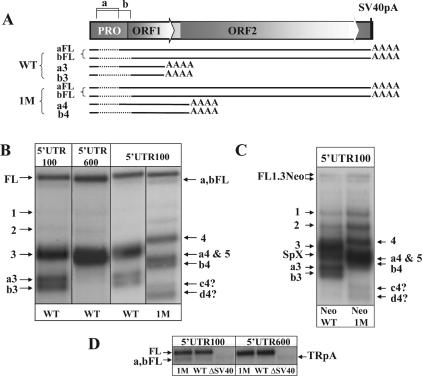Figure 5.
The relationship between polyadenylation and splicing of L1 transcripts. (A) A diagram of the L1.3-notag construct. Diagrams of the major splice variants detected by northern blot analysis of the wild type (WT) and mutant of the strongest poly(A) site (1M) L1.3 elements are shown underneath the construct. Solid black lines represent L1.3 sequences included into RNA transcripts. Dotted lines represent regions of L1.3 sequence removed by splicing. Some ‘a’ and ‘b’ splicing events may use poly(A) sites at the end of the L1 genome (a,bFL in WT and 1M elements), while others may prematurely terminate at the internal L1 poly(A) signals (‘a3’ and ‘b3’ in the WT and ‘a4’ and ‘b4’ in the 1M L1.3). (B) Northern blot analysis of the WT and 1M L1.3-notag constructs transiently transfected in NIH 3T3 cells with 5′UTR100 and 5′UTR600 strand-specific probes. Full-length L1.3 mRNA and spliced L1.3 mRNA terminated at the end of the L1 genome are marked as FL and a,bFL, respectively. Spliced and prematurely truncated mRNAs are marked as ‘a3’, ‘b3’, a4, b4. The star denotes bands with an as yet uncharacterized combination of splicing and polyadenylation that arise in the 1M mutant. (C) Northern blot analysis of the WT and 1M L1.3Neo constructs transiently transfected in NIH 3T3 cells with 5′UTR100 strand-specific probe. Full-length L1.3Neo mRNA is labeled FL1.3Neo. The splice variant specific to this vector is shown as SpX. Spliced and prematurely truncated mRNAs are identified as described in (B). (D) Northern blot analysis of the full-length and faster-migrating L1.3 mRNAs produced by the WT, 1M and ΔSV40 (L1.3 with no pA site at the end of the element) L1.3 constructs with 5′UTR100 and 5′UTR600 strand-specific probes. TRpA stands for the truncated polyadenylated L1.3 mRNA. Other products are marked as described above.

